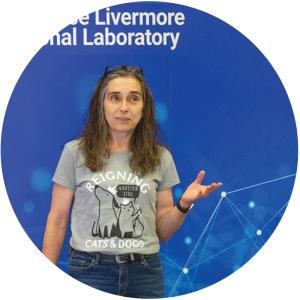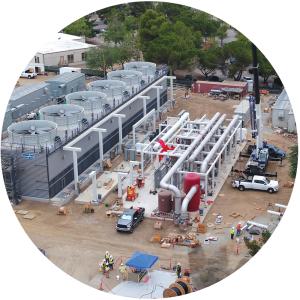Conducting safe, secure, and environmentally sound operations and modernizing the Laboratory’s infrastructure to meet evolving mission needs
Committed to the highest level of operational performance, LLNL implements best practices in environment, safety, and health (ES&H) and security. Management systems support continuous improvement in work practices. Prudent risk management coupled with active measures to prevent accidents ensures the safety of employees and the public. Investments are targeted to modernize the Laboratory’s infrastructure.
Return to New Normal
In June 2021, LLNL Director Kimberly Budil announced the start of a deliberate process to “Return to New Normal” (RTNN) at the beginning of FY 2022. Planning for RTNN had begun months earlier with a focus on designing a hybrid work environment with a flexible policy that would accommodate telecommuting—consistent with employee’s work responsibilities—as part of the future work environment. Since July 2020, LLNL had been operating effectively under Normal Operations with Maximum Telework status. Most of the staff teleworked full- or nearly full-time. In this hybrid environment, LLNL delivered on its national security mission. Success depended on people—what they did, not where they worked. This positive result guided the crafting of the new policy. RTNN transforms LLNL into a hybrid workplace as the new normal for the future. The policy acknowledges the many possible ways employees and their work groups might operate most effectively. Employees partnered with their supervisors, project leaders, and group leaders to develop a telework agreement for approval.
RTNN represents a new and exciting way for LLNL to deliver on its national security mission, with an increased level of flexibility to meet the work–life balance needs of an exceptional workforce. The transition to RTNN is being conducted in partnership with NNSA and the Livermore Field Office through a deliberate process. The policy will be improved through adjustments as lessons are learned from experience.
Onsite COVID Testing and Vaccination
In early December 2020, LLNL officially launched onsite COVID-19 testing operations to enhance health and safety measures for the workforce. This capability has provided timely test results for workers that have been symptomatic and/or may have been exposed to the SARS-CoV-2 virus and has enabled random screening to reduce the potential of asymptomatic transmissions. LLNL’s Health Services Department (HSD) worked diligently to field, staff, and coordinate a process for workers to order a test that is scheduled and conducted on premise. The team built and optimized the end-to-end testing process essentially from scratch. In addition, a new clinical testing laboratory was established and accredited. This process involved recruiting and hiring staff with extensive clinical testing experience, receiving certification for clinical testing in the State of California, and implementing steps to meet strict requirements. Called the Capability for Return of the Offsite Workforce Now (CROWN) Laboratory, this lab completed a rigorous verification test to demonstrate its proficiency with the chosen SARS-CoV-2 diagnostic test.
HSD also took on the challenging task of establishing LLNL as a Point of Dispensing (POD) for COVID-19 vaccines. The COVID Vaccination Clinic required staffing as well as development of processes and procedures for vaccination work flow, vaccine management and storage, and data management and reporting to meet POD requirements. More than 4,500 vaccine doses were successfully administered to LLNL, Sandia, and federal employees during a roughly 3-week period. Onsite COVID vaccination, which continues to be offered, is aiding in the RTNN process and supporting federal vaccine mandates.
Ensuring Safety in the Workplace
In March 2021, prompted by the increasing number of employees returning to work onsite, the Laboratory established a task force to evaluate the safety, reliability, and effectiveness of LLNL’s 3,200 heating, ventilation, and air conditioning (HVAC) systems in preventing the spread of SARS-CoV-2. Initial assessments led to hundreds of HVAC filtration upgrades. The task force also developed guidance on the use of high-efficiency particulate absorbing (HEPA) filters in offices as well as means and methods to improve ventilation where HVAC filtration could not be increased due to mechanical limitations. These engineered controls served to complement LLNL’s safety guidance on occupancy limits and use of face masks.
Investing in Infrastructure
In FY 2021, LLNL’s Institutional Project Management Office oversaw more than 300 projects amounting to approximately $1.2 billion in total project costs. More than one-third of these projects were completed—overall at $14 million under budget. Another third are actively being designed or constructed. The rest are in the pipeline or being planned. Completed projects include a new office building and a conference annex in the Livermore Valley Open Campus (see Managing for the Future) and buildings in the 2200 block, which are part of the Applied Materials and Engineering Complex and the focal point for the Polymer Production Enclave (see Partnerships).
Two major construction projects are nearing completion, and both are running under budget. More than 92 percent complete, the $100 million Exascale Computing Facility Modernization (ECFM) project provides the infrastructure needed to support El Capitan (see Nuclear Deterrence) and its successor later in the decade. The industrial-scale project required seven years of planning and multiple reviews, approval from the California Public Utilities Commission, and close collaboration with utility providers. ECFM will nearly double the energy capacity of the LLNL Computing Complex, while energy-efficient El Capitan will provide a factor of ten more computing capability. The upgrade will supply up to 85 megawatts—enough for about 75,000 modest-sized houses—to power the Laboratory’s computers and triple the amount of cooling. Work crews also added six 3,000-ton cooling towers and requisite piping, pumps, and heat exchangers. Another project, construction of the new 20,550-square-foot Emergency Operations Center (EOC), is more than 70 percent complete and ahead of schedule. It will consolidate the Laboratory’s emergency response functions and provide 24/7 operations. The EOC is an NNSA NA-50 Pilot Project that is successfully demonstrating the streamlining of commercial-like Line Item projects in the $20–$50 million cost range.
Monitoring Air Quality During Wildfires
Following the major wildfires in California in 2020, LLNL recognized the need for better data to make critical ES&H decisions regarding personnel working outdoors. A multiorganizational team worked quickly to establish a real-time, site-specific air particulate monitoring network. The network, which includes one unit at the main Livermore site and two at remote Site 300, provides LLNL management high-quality data for taking proper protective actions to ensure worker safety.








